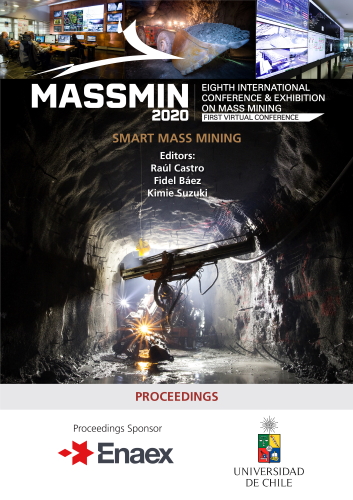Reopening and closure of a block cave

|
Authors: Paetzold, H; Lourens, P; Brazier, R |
This paper is hosted with the kind permission of Lulea University of Technology, International Conference & Exhibition on Mass Mining, 2024.
DOI https://doi.org/10.36487/ACG_repo/2063_02
Cite As:
Paetzold, H, Lourens, P & Brazier, R 2020, 'Reopening and closure of a block cave', in R Castro, F Báez & K Suzuki (eds), MassMin 2020: Proceedings of the Eighth International Conference & Exhibition on Mass Mining, University of Chile, Santiago, pp. 103-114, https://doi.org/10.36487/ACG_repo/2063_02
Abstract:
Palabora is a deep, hard rock, block cave in South Africa that has been in operation since 2002. After the open pit reached it maximum depth at 825 m, the mining method was changed from open pit to block caving. The first block cave lift (Lift I) was established 400 m below the open pit at a depth of 1,200 m and has been in production since 2002, with a capacity of 33,000 tonnes ore per day, hoisted through a production shaft to surface. The second block cave (Lift II) is currently being developed 450 m below Lift I. Over the next 3 years Lift I is expected to ramp down slowly while Lift II ramps up, to maintain 32,000 tonnes of ore per day during steady state production. During July 2018 an unfortunate conveyor fire incident took place that forced the suspension of all conveyance of material from underground to surface. Draw from the Lift I cave was suspended for approximately 10 months while the main (conveyor 5) ore conveying system was rebuilt. Lift II development continued during this period with development material trucked up to the Lift I extraction level, which was used as a stockpile area. Although Lift I is in its final stages of production there is sufficient copper remaining to justify its re-opening. There are multiple risks that needs to be taken in consideration during the process of restarting the cave. This includes but is not limited to; re-compaction, premature and/or accelerated convergence of accesses (crosscut drives), seismicity and the uncontrolled flow of material through drawpoints. Re-opening planning included assessing risks and identifying mitigation measures, which included the sequencing of draw and continuous monitoring through visual observations and convergence measurements. The objective of this paper is to give an account of the reopening process step by step , providing a record of the actual execution (implementation), including a description of the rock mass response, the challenges experienced and how these were addressed, as well as successes achieved throughout the process. These challenges also include, but are not limited to, the impact that the Lift I and Lift II cave activities have on each other.
References:
Basson, I, Lourens,P, Paetzold, H, Thomas, S, Brazier, R & Molabe, P 2016, ‘Structural Analysis and 3D Modelling of Major Mineralizing Structures at the Phalaborwa Copper Deposit’, Journal – Ore Geology Reviews, vol. 83
Glazier, SN & Hepworth, N 2005, ‘Seismicity Induced by Cave Mining, Palabora Experience’, in Y Potvin & M Hudyma (eds), Proceedings of the Sixth International Symposium on Rockburst and Seismicity in Mines Proceedings, Australian Centre for Geomechanics, Perth, pp. 281-289,
Ngidi,S & Boshoff,P 2007, ‘Cave management and secondary breaking practices at Palabora Mining Company’, Journal – South Africa Institute of Mining and Metallurgy, vol. 107, no. 12, pp. 782-789
© Copyright 2025, Australian Centre for Geomechanics (ACG), The University of Western Australia. All rights reserved.
View copyright/legal information
Please direct any queries or error reports to repository-acg@uwa.edu.au
View copyright/legal information
Please direct any queries or error reports to repository-acg@uwa.edu.au
